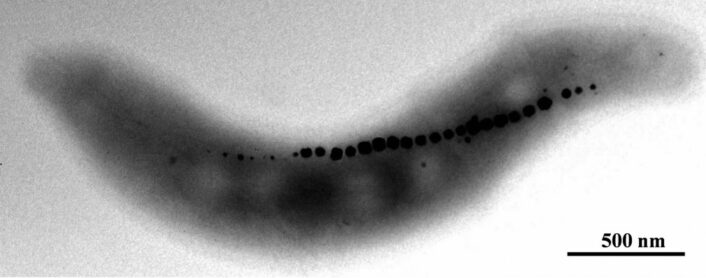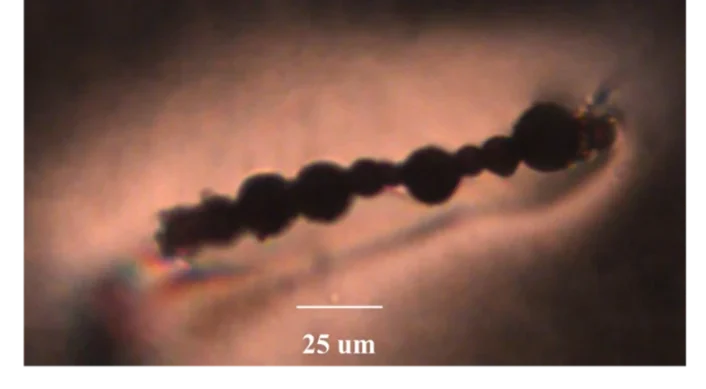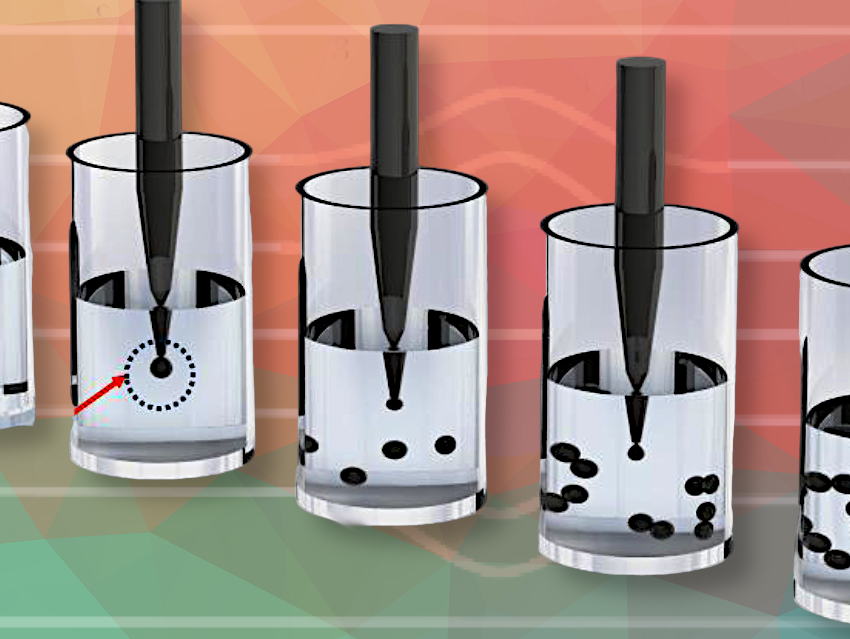Ingo Dierking and colleagues from the University of Manchester, UK, explore how ferrofluids, when dispersed in liquid crystals, form unique droplet chains with magnetic functionality. These chains, stabilized with surfactants, can be precisely controlled with external magnetic fields.
By examining the formation, movement, and stability of these chains they aim to innovate materials with potential applications in advanced technology.
What did you do?
A non-miscible ferrofluid was dispersed in a nematic liquid crystal of rod-like molecules at micrometer droplet size. Due to molecular self-organization, the liquid crystal orients the molecular long axis parallel, with a local average direction called the director. The colloid-like droplets lead to the formation of topological defects in the liquid crystal director field which causes an attractive force between the droplets, leading to chaining. These ferrofluid droplet chains are then coated with surfactants and lipids for stabilization and moved through the liquid crystal by application of a magnetic field, measuring their terminal velocity.
Why are you doing this?
Based on single ferrofluid droplets, the determination of the terminal velocity allows the microscopic measurement of the direction-dependent viscosity of the liquid crystal. The viscosity anisotropy can thus be determined for samples of masses of the order of milligrams, instead of much larger quantities required for conventional methods. In addition, the surface boundary layer thickness of the droplet can be determined.
Furthermore, we can gain a fundamental understanding of how Stokes’ law must be modified for elongated chains instead of spherical droplets, and what the influence of surface modifications is on the parameters determined.
What is new and cool about your work?
Viscosity measurements on liquid crystals are generally difficult and require large volumes of material. The new method introduced allows accurate measurements of the viscosity not only for isotropic liquids but also for anisotropic liquid crystals with a minimum of material used.
What are your key findings?
The key findings of the publication are that, in contrast to solid microspheres, the ferrofluid droplets show a boundary layer of a thickness between 3–5 µm. Within this layer, the magnetization induced by the external magnetic field is canceled. Including this layer into calculations leads to values for viscosity and its anisotropy comparable to those obtained through more complex, material-intensive methods.
Considering the formation of droplet chains, we provide evidence supporting the proposed theoretical modification of Stokes’ law. Normally, Stokes’ law describes the movement of spherical particles in a fluid. However, when these droplets form elongated chains, the original law requires modification to accurately predict their behavior.
Different surface coatings with surfactants and lipids have no significant influence on viscosity or boundary layer, likely due to the short length of these molecules as compared to the size of the chains.
What is the longer-term vision for your research?
The ultimate aim of these experiments is the bio-mimicking of magnetotactic bacteria and comparing the behavior of artificial and biological bacterial motion.

Figure 1. A magnetotactic bacteria containing a chain of magnetosomes [1].
Magnetotactic bacteria (see Fig. 1) contain a chain of solid magnetosomes, which are surrounded by a lipid bilayer and dispersed in water. This is mimicked by the chain of magnetofluid droplets surrounded by a lipid bilayer in a liquid crystal carrier fluid (see Fig. 2). Studies of this kind are the first step in incorporating magnetic structures into biomimicry with liquid crystals.

Figure 2. Chain of ferrofluid droplets in a nematic liquid crystal. The bright corona around the chain is due to a deformed director field from the adsorbed lipid molecules.
What part of your work was the most challenging?
The most challenging part of the study is the chain formation of ferrofluid droplets of sufficient length and spheres of roughly the same size. We are overcoming this challenge by using microfluidics and coating the droplet chain with a range of surfactants and lipids to decide which has the most significant effects.
Thank you very much for these insights.
The paper they talked about:
- Ferrofluid Droplet Chains in Thermotropic Nematic Liquid Crystals,
Varun Chandrasekhar, Jian Ren Lu, Ingo Dierking,
ChemPhysChem 2024.
https://doi.org/10.1002/cphc.202400858
Ingo Dierking is an Associate Professor at the University of Manchester, School of Physics and Astronomy in the UK.
Reference
[1] Christopher T. Lefèvre, Dennis A. Bazylinski, Ecology, Diversity, and Evolution of Magnetotactic Bacteria, Microbiol. Mol. Biol. Rev. 2023, 77. https://doi.org/10.1128/mmbr.00021-13





